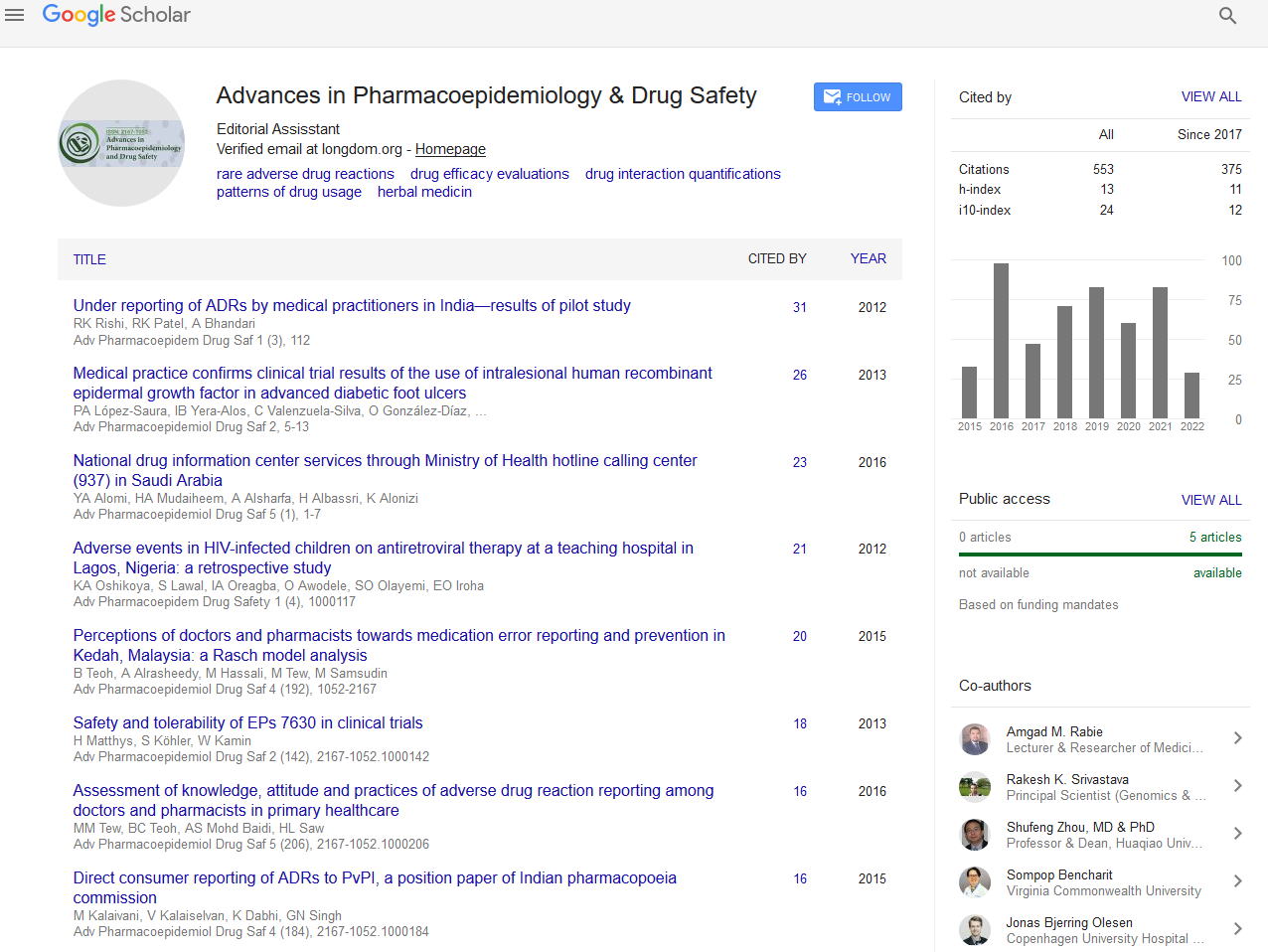Indexed In
- Open J Gate
- Genamics JournalSeek
- Academic Keys
- JournalTOCs
- RefSeek
- Hamdard University
- EBSCO A-Z
- SWB online catalog
- Publons
- Geneva Foundation for Medical Education and Research
- Euro Pub
- Google Scholar
Useful Links
Share This Page
Journal Flyer

Open Access Journals
- Agri and Aquaculture
- Biochemistry
- Bioinformatics & Systems Biology
- Business & Management
- Chemistry
- Clinical Sciences
- Engineering
- Food & Nutrition
- General Science
- Genetics & Molecular Biology
- Immunology & Microbiology
- Medical Sciences
- Neuroscience & Psychology
- Nursing & Health Care
- Pharmaceutical Sciences
Knowledge, attitude, and practiceon human papilloma virus vaccination: A cross sectional study among university students
11th International Conference on Pharmacoepidemiology and Clinical Research
October 02-03, 2017 Kuala Lumpur, Malaysia
Fahrni ML, Aziz NA, Azni MZ and Hassan Y
Universiti Teknologi MARA, Malaysia
Universiti Teknologi MARA (UiTM), Malaysia
Scientific Tracks Abstracts: Adv Pharmacoepidemiol Drug Saf
Abstract:
Introduction: Cervical cancer is the third most common cancer among women worldwide. Human Papillomavirus (HPV) is the main cause for cervical cancer as well as vulvar, vaginal, penile, anal and also oropharyngeal cancer. The burden of HPV-associated disease is still high across numerous countries regardless of the technological advancement in conveying information pertaining to the disease. Lack of awareness on HPV as well as misunderstandings on the risks associated with HPV vaccination can expose females to the disease and complications that arise from HPV. Objective: To evaluate the knowledge, attitude and perception on HPV immunization among female students in a public university and to compare the scores between the medical-related group vs the non-medical-related group of students. Method: A cross-sectional study was conducted among female students in the city of Puncak Alam, located in the state of Selangor in Western Malaysia. Data was collected from March until May 2017. Respondents were enrolled in Health Science, Pharmacy, Business and Management, Health and Tourism or Arts and Design. Respondents were randomly chosen and those who fulfilled the criteria were included. Respondents were given participant information sheet and informed consent form which contained information about the background, confidentiality issues, purpose, procedure, risks and benefits associated with the study. Respondents signed the informed consent and indicated their willingness to participate. The questionnaire was then self-administered. The questionnaire consist of three parts: Part A �?? Demographic profile Part B �?? Knowledge about Human Papilloma Virus and HPV vaccine Part C �?? Attitude and perception toward HPV and HPV vaccine Data were collected was analyzed using Statistical Package for Social Science (SPSS) software Ver23 and Microsoft Excel 2013. Descriptive analysis was conducted for demographic characteristics and respondents�?? knowledge on HPV and HPV vaccine. Chi-square test was used to analyze the association between groups. Pearson correlation was used to determine the relationship between knowledge, perception and attitude to immunization by HPV vaccine. Results: A total of n=200 female students with a mean age of 22 were included. Most of the respondents that participated in the study were undergraduate (Degree) students (95%) followed by Diploma students (4.5%) and PhD students (0.5%). The largest proportion was from the faculty of Health Science (n=99, 49.5%), Pharmacy (n=1, 0.5%), Hotel and Tourism (n=1, 0.5%), Business Management (n=50, 25.0%) and Art and Design (n=49, 24.5%). The respondent�??s current study year range from 2nd year (n=46, 23.0%), 3rd year (n=148, 74%) 4th year (n=5, 2.5%) and Post-graduate (n=1, 0.5%). For vaccination status, 27.18% of the 200 respondents had completed the immunization through a series of 3 shots. 28.77% (n=63) of females had already completed their immunization schedule and 19.63% (n= 43) of the female had received only the first shot. The remaining 2.74% (n=6) had not received any shot but already scheduled an appointment with their respective doctor for the HPV vaccine while 40.18% (n=88) had not received the HPV vaccine and had not scheduled an appointment for HPV vaccine. As for awareness, 87% (n=174) of the females were aware about Human Papillomavirus before answering the questionnaire and 7% (n=14) had never heard about Human Papillomavirus. The other 6% (n=12) were not unsure. Most of them (71%, n= 142) were aware about the availability of the vaccine but only 9.5% (n=19) were aware that HPV vaccine was also available for men A Mann-Whitney test indicated that the level of knowledge regarding HPV was greater for medical-related students (Mdn = 6.50) than for non-medical-related students (Mdn = 1.50), U= 2790.5, p-value = 0.00). Significant differences were observed between the groups favouring medical-related students regarding effectiveness of HPV vaccination in oral cancer prevention and also effectiveness of the vaccine in preventing the spread of HPV to partners (p=0.014). No significant differences was found in attitude of HPV between the two groups. Most of the respondents�?? attitude toward immunization was influenced by perceived benefits, barrier to vaccination, and external influences. Conclusion: The study highlighted that rates of vaccination is low. Generally, the level of knowledge, attitude and perception on HPV immunization among a sample of students is moderate. There was a significant difference in all three levels between medical-relate students and non-medical-related students. There is much room for improvement despite government efforts through the National Immunization Programme which started in 2010.


